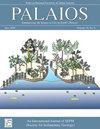用有孔虫组合表征现代和全新世堰洲岛环境:以美国北卡罗来纳州以波浪为主导的微潮堰洲岛系统为例
IF 1.5
4区 地球科学
Q2 GEOLOGY
引用次数: 0
摘要
摘要:最近的研究表明,屏障岛环境中的沉积学信息可能比基于有孔虫的解释更详细地解释过去的一些海岸环境。这项研究调查了在特定海岸环境中对现代有孔虫的有针对性的记录是否可以导致更高分辨率的基于微体学的古环境重建。北卡罗来纳州的熊岛以人类干扰较少为特征,被选为现代屏障岛相关环境中有孔虫的详细记录地。所有亚环境中的现代沉积物成分主要为硅质碎屑(<30%的碎屑碳酸盐碎屑):碎屑碳酸盐异地碎屑(如软体动物外壳碎片、棘皮棘)与细粒至中粒石英砂混合。通过判别分析检验了26个现代海岸亚环境的现代有孔虫组合可以根据它们的有孔虫群落进行区分的假设,并识别出四个环境超群:滨面、潮落三角洲、潮洪三角洲/入水道,和“屏障组合”(前滨、冲刷、沙丘、沙坪、沙嘴、沿岸坝和槽)。基于现代数据集,通过判别分析,解释了从紧邻熊岛的Bogue Banks的现代内陆架、海岸面、潮落三角洲和入口环境中收集的16个振动体中的有孔虫组合所代表的全新世古环境。全新世和现代有孔虫组合相似,但物种丰度和物种多样性的变化允许在不同概率水平上对岩芯样本进行替代古环境分类。这项研究的方法广泛适用于其他沿海环境。本文章由计算机程序翻译,如有差异,请以英文原文为准。
CHARACTERIZING MODERN AND HOLOCENE BARRIER-ISLAND ENVIRONMENTS WITH FORAMINIFERAL ASSEMBLAGES: AN EXAMPLE FROM A WAVE-DOMINATED, MICROTIDAL BARRIER-ISLAND SYSTEM, NORTH CAROLINA, USA
Abstract: Recent research has shown that sedimentological information in barrier-island settings may provide more detailed interpretations of some past coastal environments than interpretations based upon foraminifera. This research investigates whether targeted documentation of modern foraminifera in specific coastal environments can result in higher resolution micropaleontology-based paleoenvironmental reconstructions. Bear Island, North Carolina, characterized by little human disturbance, was chosen for detailed documentation of foraminifera in modern barrier-island-related environments. Modern sediments in all subenvironments were predominantly siliciclastic (< 30 % clastic carbonate debris) in composition: clastic carbonate allochems (e.g., mollusk shell fragments, echinoid spines) were admixed with fine- to medium-grained quartz sand. The hypothesis that modern foraminiferal assemblages of 26 modern coastal subenvironments can be distinguished based upon their foraminiferal assemblages was tested by discriminant analysis and resulted in the recognition of four environmental supergroups: shoreface, ebb-tidal delta, flood-tidal delta/inlet channel, and “barrier-combined” (foreshore, washover, dune, sandflat, spit, longshore bar, and trough). Holocene paleoenvironments represented by foraminiferal assemblages in 16 vibracores collected from the modern inner shelf, shoreface, ebb-tidal delta, and inlet environments of Bogue Banks, immediately adjacent to Bear Island, were interpreted, via discriminant analysis, based upon the modern dataset. Holocene and modern foraminiferal assemblages were similar but variations in species abundance and species diversity allowed for alternative paleoenvironmental classification of core samples at varying levels of probability. The methodology of this research is widely applicable to other coastal environments.
求助全文
通过发布文献求助,成功后即可免费获取论文全文。
去求助
来源期刊

Palaios
地学-地质学
CiteScore
2.80
自引率
12.50%
发文量
40
审稿时长
6 months
期刊介绍:
PALAIOS is a monthly journal, founded in 1986, dedicated to emphasizing the impact of life on Earth''s history as recorded in the paleontological and sedimentological records. PALAIOS disseminates information to an international spectrum of geologists and biologists interested in a broad range of topics, including, but not limited to, biogeochemistry, ichnology, paleoclimatology, paleoecology, paleoceanography, sedimentology, stratigraphy, geomicrobiology, paleobiogeochemistry, and astrobiology.
PALAIOS publishes original papers that emphasize using paleontology to answer important geological and biological questions that further our understanding of Earth history. Accordingly, manuscripts whose subject matter and conclusions have broader geologic implications are much more likely to be selected for publication. Given that the purpose of PALAIOS is to generate enthusiasm for paleontology among a broad spectrum of readers, the editors request the following: titles that generate immediate interest; abstracts that emphasize important conclusions; illustrations of professional caliber used in place of words; and lively, yet scholarly, text.
 求助内容:
求助内容: 应助结果提醒方式:
应助结果提醒方式:


